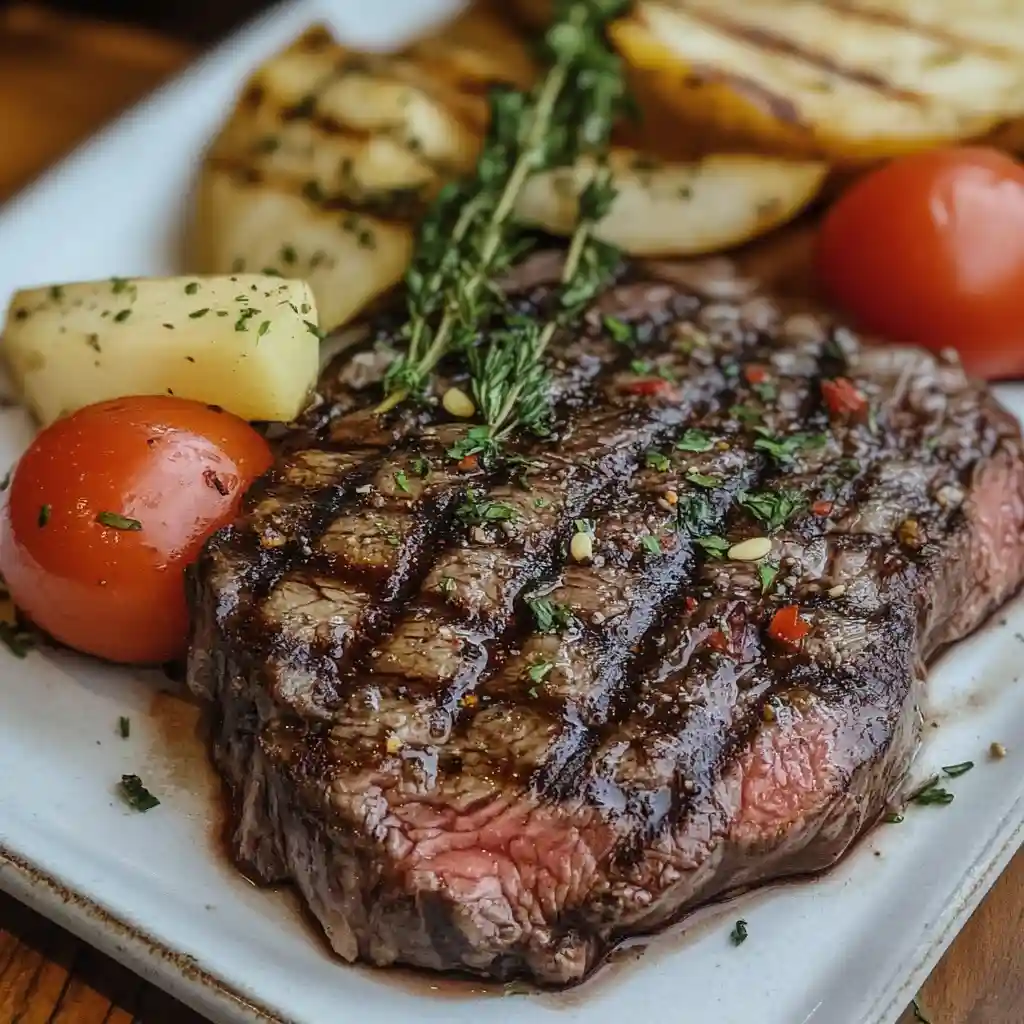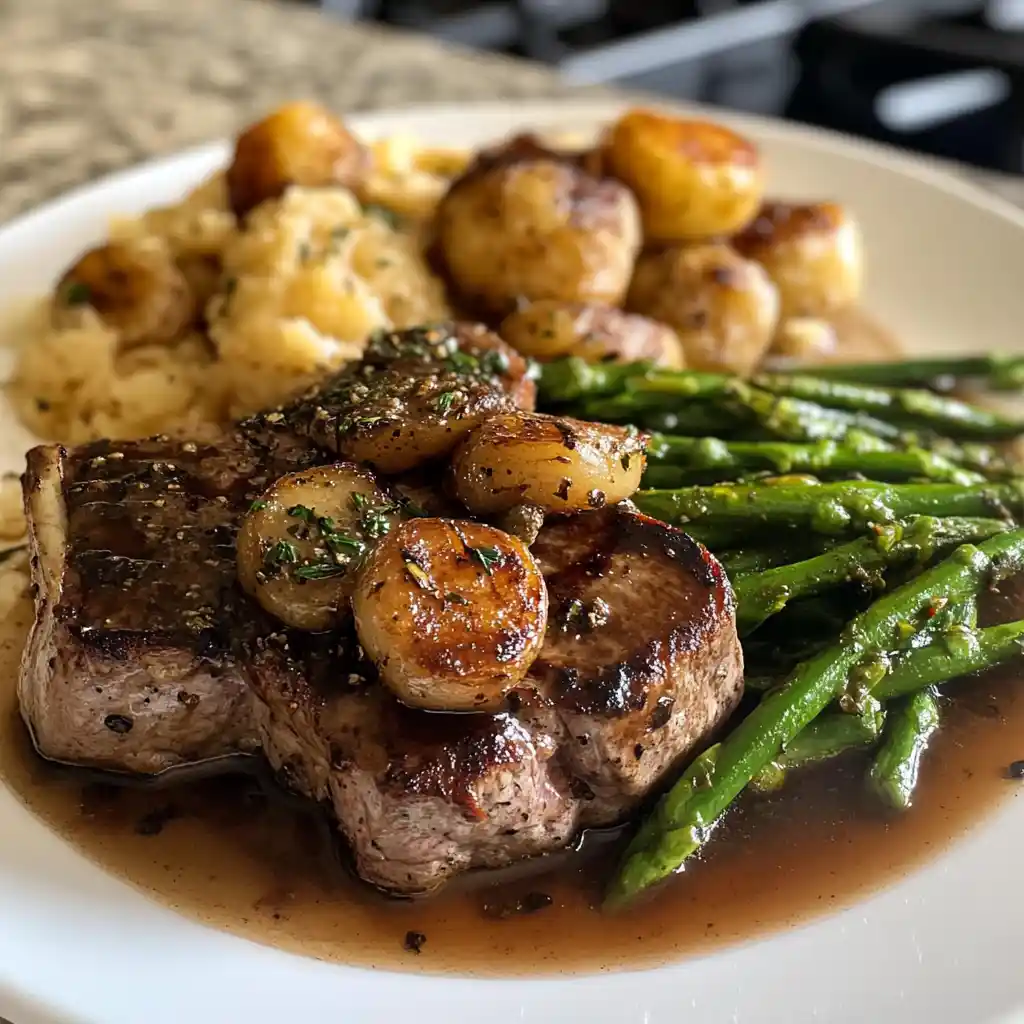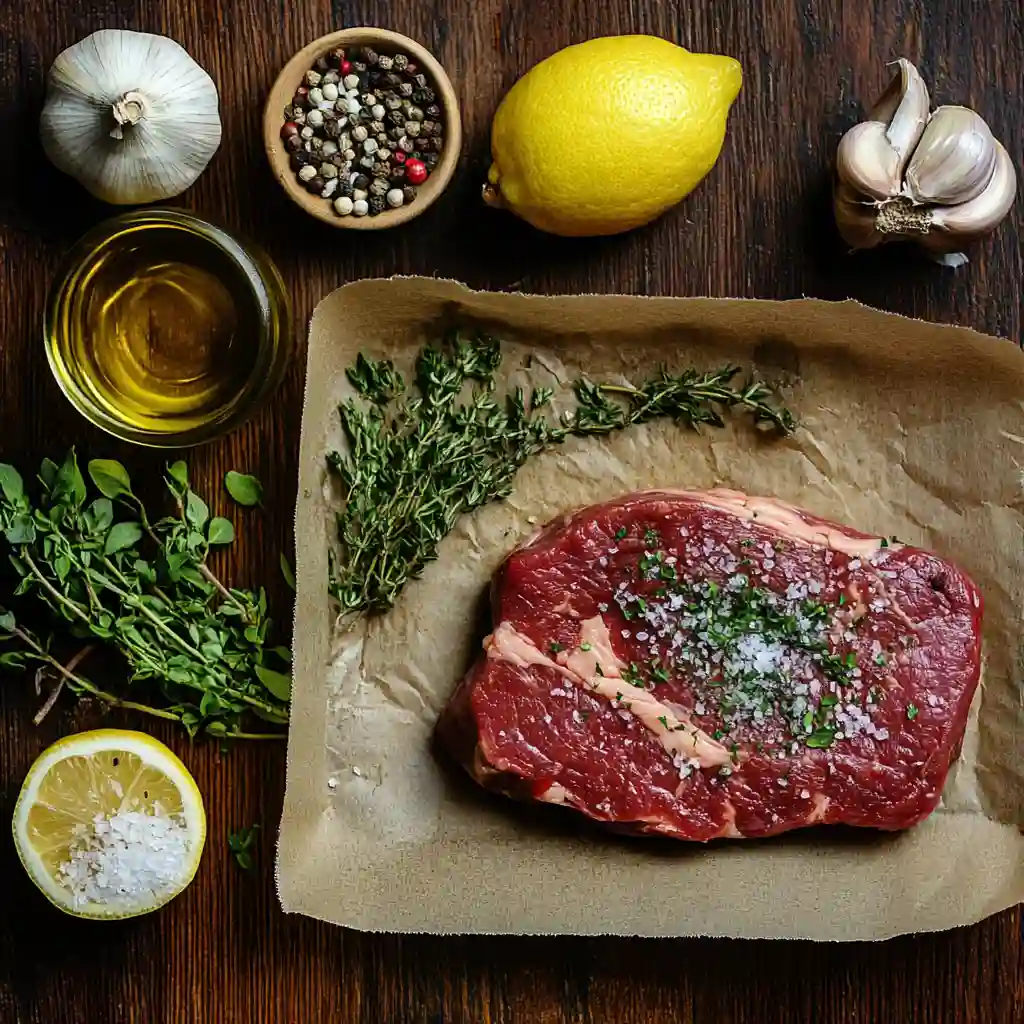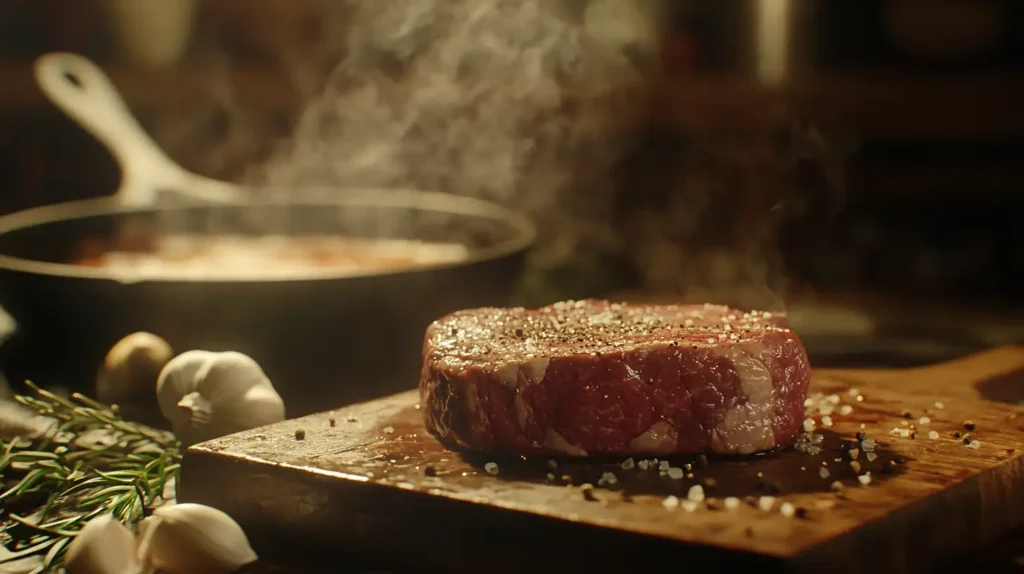The beef chuck eye steak, often hailed as the “poor man’s ribeye,” is a gem in the culinary world. This cut of meat, taken from the shoulder area near the ribeye, offers a rich, beefy flavor at an affordable price. Its marbling and tenderness make it a favorite among home cooks and grill enthusiasts alike.

Whether you’re searing it in a pan, grilling over open flames, or preparing a hearty meal indoors, the chuck eye steak is versatile enough to suit various cooking methods. It’s no wonder this cut has earned a spot in kitchens everywhere.
Jump to:
What is Beef Chuck Eye Steak?
Beef chuck eye steak is a flavorful and budget-friendly cut of beef, often considered a close cousin to the ribeye. Sourced from the chuck primal section of the cow, this steak offers a tender texture and rich marbling, making it a satisfying choice for many meals. Its affordability and versatility have made it a staple for both casual cooking and impressive dinners.
Understanding the Cut of beef chuck eye steak
Chuck eye steak comes from the shoulder region, specifically near the transition point between the rib and chuck primal cuts. This area provides the steak with some of the tenderness and marbling that ribeye is known for, though at a more accessible price point. Its flavor-packed profile makes it ideal for various cooking techniques, from grilling to broiling.
Location on the Cow
The chuck eye steak is located in the fifth rib section of the cow, adjacent to the prized ribeye cut. This proximity explains its similar texture and taste. While only a few chuck eye steaks can be sourced from each cow, they are a hidden treasure for meat lovers seeking quality without overspending.
Characteristics of Chuck Eye Steak
Beef chuck eye steak is well-known for its marbling, which contributes to its juicy and savory flavor. It has a slightly coarser texture compared to ribeye, but with proper cooking, it becomes tender and delectable. This cut typically has a generous fat content, which enhances its taste and helps lock in moisture during cooking. Whether grilled or pan-seared, it delivers a satisfying bite every time.
Why It’s Known as the “Poor Man’s Ribeye”
The beef chuck eye steak has earned its nickname, “poor man’s ribeye,” due to its affordability and striking similarities to the premium ribeye cut. While not identical, the chuck eye offers a comparable eating experience, making it a popular choice for those who love the taste of ribeye but are mindful of their budget.

Similarities to Ribeye
Chuck eye steak shares several characteristics with ribeye, as they come from adjacent parts of the cow. Both cuts feature a rich, beefy flavor and noticeable marbling that melts during cooking, enhancing their juiciness. Additionally, chuck eye steak can be cooked using the same methods as ribeye, such as grilling or pan-searing, delivering a similarly satisfying experience at a fraction of the cost.
Differences in Texture and Flavor
While chuck eye steak mimics ribeye in many ways, there are some distinctions. Chuck eye steak has a slightly coarser texture due to its location in the shoulder area. Its flavor is robust and beef-forward, with a bit less of the buttery richness that defines ribeye. Despite these differences, proper cooking techniques can bring out the best in chuck eye steak, making it a delicious and budget-conscious alternative.
How to Select the Best Beef Chuck Eye Steak
Selecting a high-quality beef chuck eye steak is key to enjoying its full potential. By focusing on specific features, you can ensure a tender, flavorful cut that cooks beautifully. Here’s what to look for when choosing your steak.
Tips for Choosing Quality Cuts of beef chuck eye steak
When shopping for beef chuck eye steak, pay close attention to its visual and physical qualities. A fresh, well-marbled steak with vibrant color is usually the best choice. Additionally, consider sourcing your steak from a trusted butcher or meat counter to guarantee better quality.
Marbling and Fat Content
One of the most important factors to consider is the marbling—the streaks of fat running through the meat. Well-marbled chuck eye steaks are more flavorful and tender, as the fat melts during cooking to enhance the meat’s juiciness. Look for evenly distributed marbling, avoiding cuts with large, hard fat deposits that won’t render down.
Color and Freshness
Fresh beef chuck eye steak should have a bright, cherry-red color. Avoid cuts that appear dull, brownish, or have an off-putting odor, as these may indicate aging or improper storage. The steak should also feel firm to the touch, signaling its freshness and quality. Opt for vacuum-sealed packaging or steaks displayed in a clean, well-maintained cooler.
Ingredients for Beef Chuck Eye Steak
Preparing a delicious beef chuck eye steak requires a few simple ingredients to enhance its natural flavors. Here’s a basic list:

Essential Ingredients:
- Beef Chuck Eye Steak: Select a steak that is well-marbled and fresh.
- Salt: Use coarse kosher salt or sea salt to season the steak generously.
- Pepper: Freshly ground black pepper adds a bold, aromatic kick.
Optional Additions for Flavor:
- Garlic: Minced or crushed garlic can be rubbed onto the steak or added to the pan for extra flavor.
- Butter: A knob of butter melted on top adds richness and moisture.
- Fresh Herbs: Rosemary, thyme, or parsley pair beautifully with beef and can be used as garnish or infused during cooking.
- Olive Oil: A light coating helps with browning, especially if grilling or pan-searing.
- Lemon Juice: A squeeze of fresh lemon can brighten the flavor and balance the richness of the steak.
These simple yet flavorful ingredients are all you need to make your beef chuck eye steak shine, whether grilling, broiling, or pan-searing.
Preparing Beef Chuck Eye Steak
Proper preparation is key to bringing out the best in your beef chuck eye steak. Follow these essential tips to ensure your steak is flavorful and perfectly cooked.

1. Bring the Steak to Room Temperature
Before cooking, let the steak sit at room temperature for 20–30 minutes. This ensures even cooking and prevents the steak from being cold in the center while overcooked on the outside.
2. Pat the Steak Dry
Use paper towels to pat the steak dry on all sides. Removing excess moisture helps achieve a beautifully browned and crispy crust during cooking.
3. Season Generously
Season the steak with coarse salt and freshly ground black pepper at least 30 minutes before cooking. This allows the seasoning to penetrate the meat, enhancing its flavor. For an extra kick, consider adding a touch of garlic powder or smoked paprika.
4. Use the Right Cooking Oil
Choose a high smoke point oil, such as avocado oil or vegetable oil, for searing the steak. This prevents the oil from burning and ensures a flavorful crust.
5. Preheat Your Cooking Surface
Whether you’re grilling or pan-searing, preheat the surface to high heat before adding the steak. A hot surface helps lock in juices and creates a delicious caramelized exterior.
6. Let it Rest
After cooking, allow the steak to rest for 5–10 minutes. Resting helps the juices redistribute throughout the meat, resulting in a tender and juicy steak.
By following these prepping tips, your beef chuck eye steak will turn out perfectly seasoned, tender, and full of flavor every time.
Cooking Methods for Beef Chuck Eye Steak
Beef chuck eye steak is versatile and lends itself well to various cooking techniques. One of the most popular and effective methods is grilling, which brings out its rich, smoky flavors.
Grilling Beef chuck eye steak
Grilling is a top choice for cooking chuck eye steak due to the high heat and direct contact with the flames, which create a delicious crust while sealing in the juices.
Direct vs. Indirect Heat
- Direct Heat: Perfect for quickly searing the steak. Then place the steak directly over high heat for 2–3 minutes per side to achieve a beautifully browned exterior.
- Indirect Heat: Ideal for thicker cuts or ensuring even cooking. After searing over direct heat, move the steak to a cooler section of the grill and cook until it reaches your desired doneness.
Using a combination of both methods can help you achieve a perfectly cooked steak that’s seared on the outside and tender on the inside.
Tips for Perfect Grill Marks
- Preheat the Grill: Ensure the grill is hot before placing the steak. This prevents sticking and ensures even cooking.
- Oil the Grates: Lightly brush the grill grates with oil to reduce sticking and promote clean grill marks.
- Position the Steak: Place the steak at a 45-degree angle to the grill grates. After 1–2 minutes, rotate it 90 degrees to create a crosshatch pattern.
- Avoid Flipping Too Often: Flip the steak only once during grilling to allow the marks to develop and the crust to form.
By mastering grilling techniques, you can elevate your beef chuck eye steak into a restaurant-quality dish, packed with flavor and visual appeal.
Nutritional Benefits of Beef Chuck Eye Steak
Beef chuck eye steak is not just a flavorful option; it also offers numerous nutritional benefits, making it a valuable addition to a balanced diet.
Protein Content of beef chuck eye steak
One of the standout features of beef chuck eye steak is its high protein content. A single serving provides approximately 23–26 grams of protein, depending on the cut and preparation method. Protein is essential for muscle growth, repair, and overall body function, making this steak an excellent choice for those with active lifestyles or looking to increase their protein intake.
Vitamins and Minerals
Beef chuck eye steak is a rich source of essential vitamins and minerals, including:
- Iron: Supports oxygen transport in the blood and helps combat fatigue.
- Zinc: Boosts immune function and promotes skin health.
- Vitamin B12: Essential for nerve function, DNA synthesis, and red blood cell production.
- Phosphorus: Contributes to bone health and energy metabolism.
- Selenium: Acts as an antioxidant, protecting cells from damage.
These nutrients not only support physical health but also contribute to energy levels and overall well-being. Including beef chuck eye steak in your meals can be a delicious way to meet your daily nutritional needs.
Common Mistakes to Avoid
Cooking beef chuck eye steak can be straightforward, but certain mistakes can compromise its flavor and texture. Avoiding these common errors ensures a perfectly cooked and satisfying meal.
Overcooking of beef chuck eye steak
Overcooking is one of the most frequent mistakes when preparing beef chuck eye steak. Because this cut is slightly less tender than ribeye, cooking it beyond medium doneness can result in a dry and tough texture. To avoid this:
- Remove the steak from heat slightly before it reaches your desired doneness, as it will continue to cook while resting.
- Use a meat thermometer to monitor the internal temperature. Aim for 130–135°F for medium-rare or 135–145°F for medium.
Skipping the Resting Time
Resting the steak after cooking is crucial but often overlooked. Skipping this step can cause the juices to spill out when the steak is cut, leaving it dry. To retain moisture and enhance tenderness:
- Allow the steak to rest for 5–10 minutes after cooking.
- Cover it loosely with foil during this time to keep it warm.
By avoiding overcooking and giving the steak time to rest, you can maximize its flavor, juiciness, and overall quality.
FAQ
What is beef chuck eye steak?
Beef chuck eye steak is a flavorful cut of meat taken from the shoulder area of the cow, near the ribeye.
How is chuck eye steak different from ribeye?
While chuck eye steak and ribeye come from adjacent parts of the cow and share a rich flavor, chuck eye steak has a slightly coarser texture and less marbling.
Is beef chuck eye steak tender?
Yes, it is relatively tender, especially when cooked properly.
What is the best way to cook beef chuck eye steak?
Grilling, pan-searing, or broiling are excellent methods. High heat helps to achieve a flavorful crust while maintaining juiciness inside.
Conclusion
Beef chuck eye steak is a hidden gem that combines rich flavor, versatility, and affordability. Whether you’re a home cook or a grilling enthusiast, this cut offers a satisfying alternative to pricier options like ribeye. With proper preparation and cooking techniques, you can enjoy a tender and flavorful steak that delights your taste buds.
By selecting high-quality cuts, avoiding common mistakes, and experimenting with different cooking methods, the chuck eye steak can easily become a standout feature in your culinary repertoire. Enjoy the delicious possibilities it brings to your table!
